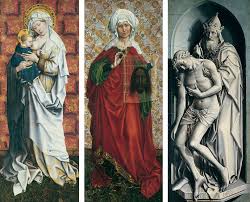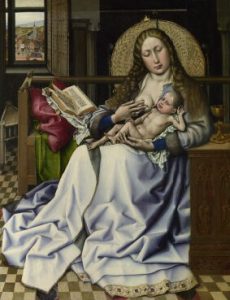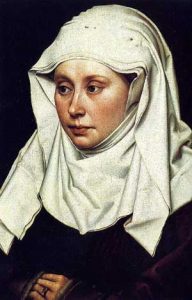Robert Campin (1375-1444) led one of the most mysterious and intriguing careers as a painter in the Early Renaissance, one that is still debated today. Labelled as one of the most talented artists of his time, Campin was highly successful and created many breathtaking pieces of art. However no work was signed or dated, leading to great speculation between Campin and “The Master of Flemalle,” an unidentified painter responsible for ornate panels that were monumental in their skill of perspective, observation, and composition. Campin primarily painted Biblical subjects, as well as private commissions. He is credited to being a main innovator in the Flemish shift between Gothic and Renaissance styles. The Getty Museum summarizes his contributions, writing “Campin humanized subject matter, breaking with the aristocratic taste and romantic mood of the ornamental International style to portray the Annunciation taking place in a contemporary middle-class Tournai home. The sculptural solidity and naturalistic detail of his style show sculptor Claus Sluter’s influence. Campin’s influence, mediated through his pupil Rogier van der Weyden, was widespread.”

I chose Campin because of the mystery of his personality and how clearly his work stands out from the other artists of the time. It is intensely realistic, painful and beautiful. Additionally, the backgrounds intrigued me almost as much as the piece itself. I feel like it is something rarely seen in the time of the early renaissance, where you have a steady, close background with a repeated pattern. Each background, whether it be a complex scene or a simple pattern, compliments the subject of the photo with realistic simplicity and depth. Campins work features a deep understanding of textures, expression, and form. He uses dramatic shadows and rich, vibrant colors to compliment a neutral background that would otherwise take away from the subject. This is excellently displayed in his work Virgin and Child before a firescreen, where the warmth and seemingly critical affection of the Madonna while she breastfeeds her child is highlighted by the excellent depiction of her pale skirt, as well as the cool backdrop.


https://www.britannica.com/biography/Robert-Campin
https://en.wikipedia.org/wiki/Robert_Campin
Getty Museum Robert Campin: http://www.getty.edu/art/collection/artists/3536/robert-campin-netherlandish-about-1375-1444/